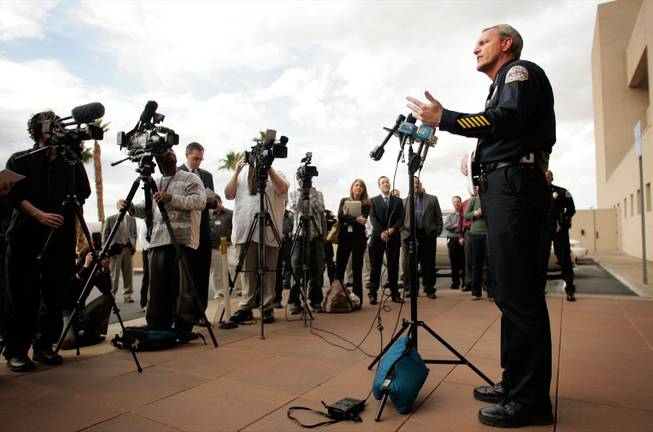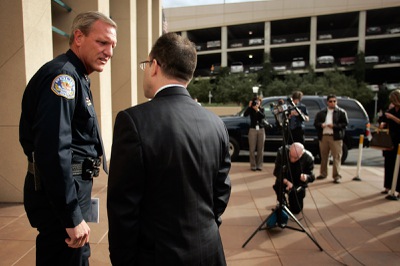
Henderson Police Chief Richard Perkins had few answers about the shooting death of Deshira Selimaj, an Albanian immigrant and mother of three, during a news conference Thursday at the Henderson Police Department.
Friday, Feb. 22, 2008 | 2 a.m.
Henderson Police Press Conference
On Thursday, Feb. 21, 2008, Chief Richard Perkins of the Henderson police department, held a press conference to address the shooting of 42-year-old Deshira Selimaj by police officer Luke Morrison.
Stepping to the microphone Thursday, Henderson’s police chief tried to clarify what happened when one of his young officers shot and killed an ice cream lady the afternoon of Feb. 12.
Instead, Chief Richard Perkins’ remarks only verified what the public already knew: The police account of the events is wildly different from those of the victim’s family and other witnesses who have spoken to various Las Vegas news organizations.
This discrepancy leaves the public still in the dark about the shooting, but it also underscores an irony of law enforcement in Southern Nevada. When it comes to everyday slayings and other violence in our valley, details are usually available from police or police documents or both. When an officer kills someone, however, no documents are released and most details are closely guarded until a coroner’s inquest is conducted, weeks if not months later. In the case of the ice cream truck driver, for example, the inquest is scheduled for April 11.
At his news conference, Perkins read a prepared speech and then answered many of the media’s questions with a refrain of “Wait for the coroner’s inquest.”
That was the answer to:
• Can you tell us about the knife Deshira Selimaj, the ice cream truck driver, was allegedly threatening police with before she was shot?
• Can you tell us more about how Selimaj, an average-sized mother of three, reportedly attacked an officer at the scene, prompting another officer to shoot?
• Can you tell us why the Tasers two officers used on Selimaj didn’t work? Or why a number of witnesses, including her children, insist she didn’t have a knife? Or why a woman who says she saw it happen told a reporter at The Home News, “It was unjustified, it was aggressive. The woman never should have been shot”?
The rationale for lumping everything under the veil of the coroner’s inquest is that the process is akin to a trial. Prosecutors from the district attorney’s office ask questions of officers and witnesses and a jury considers all the testimony and evidence before determining whether the use of deadly force was justified, excusable or criminal.
Revealing too many details about the case prior to the inquest, police argue, might taint the jury pool.
As Perkins put it, police want to avoid trying the case in the press.
“We are trying to respect the judicial system,” he said.
If anyone other than a police officer had pulled the trigger, however, police would have filled out one or more reports that under Nevada law are public records, and police typically would have answered many of the media’s questions about the case.
Before seating jurors to try any case, lawyers and judges screen out potential jurors who have followed the media reports closely and already have decided whether the defendant is guilty. The same could be done for an inquest.
Which supports a familiar refrain: The Clark County coroner’s inquest needs to be reformed.
Gary Peck, director of the Nevada American Civil Liberties Union, has worked closely with the families of police shooting victims in his role as a civil liberties watchdog, and he calls the coroner’s inquest a “stilted and one-sided sham.”
Since 1976, when the inquest process was adopted, officers have been cleared in all but one case, and that one case was years ago.
In the wake of several controversial killings by Las Vegas police — including one in which a handcuffed teen who had been arrested on a charge of murder was shot while running from police — Peck helped lead an effort to change the coroner’s inquest system last year. There were months of meetings involving people on all sides of the issue. But virtually all the changes the ACLU advocated wound up being rejected by the Clark County Commission.
Critics of the inquest process find fault in the fact that police officers, who conduct in-house investigations of any officer-involved shooting, are then questioned by district attorneys, who base their line of questioning on the police department’s report.
In a case like this one, in which several witnesses have given statements that contradict the police version of events, it remains to be seen whether those witnesses wind up delivering that testimony at the inquest.
District Attorney David Roger says his attorneys seek out additional testimony if they feel it is necessary.
Peck says he has seen attorneys and detectives do just the opposite: ignore testimony that doesn’t fit with the police version of events.
“It’s clear to me they don’t have a process for carefully identifying and vetting witnesses and making sure that all of the pertinent witnesses are called,” Peck said. “This is a government-run show.”
In the case of Deshira Selimaj, the discrepancies lie in whether Selimaj had a knife, held that knife to her child and made suicidal statements. Some witnesses report Selimaj was shot while wailing on her knees. Perkins says the coroner’s inquest will prove that Selimaj attacked an officer, and that the officer who fired the fatal bullet, 23-year-old Luke Morrison, “saved a fellow officer’s life.”
Perkins characterized Morrison as a war hero, noting that he had been in the Army prior to joining the force and had been injured in Iraq.
There are many witnesses who say Selimaj had a knife and threatened the officers, but the media has not reported their accounts, Perkins complained.
“There is a lot of misinformation out there and the officers are being unfairly characterized,” he said.


Join the Discussion:
Check this out for a full explanation of our conversion to the LiveFyre commenting system and instructions on how to sign up for an account.
Full comments policy